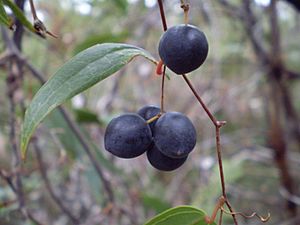Sweet sarsaparilla facts for kids
Quick facts for kids Sweet sarsaparilla |
|
|---|---|
 |
|
| Scientific classification | |
| Genus: |
Smilax
|
| Species: |
glyciphylla
|
The sweet sarsaparilla (scientific name: Smilax glyciphylla) is a climbing plant that grows naturally in eastern Australia. It is a dioecious plant, which means it has separate male and female plants. You can find it in many places, including rainforests, sclerophyll forests, and woodlands, especially near the coast.
This plant is known for its sweet-tasting leaves. People have used these leaves for a long time for their medicinal properties.
Contents
What Does It Look Like?
The sweet sarsaparilla has special leaves that are shaped like a spear (lanceolate). They are about 4 to 10 centimeters long and 1.5 to 4 centimeters wide. You can easily spot them because they have three clear veins, and their underside is a pale, bluish-green color, which is called "glaucous."
The plant also has coiling tendrils, which are like little arms that help it climb. These tendrils can grow up to 8 centimeters long. After flowering, the plant produces small, round berries. These berries are about 5 to 8 millimeters wide, black in color, and each one holds a single seed.
Traditional Uses and History
The sweet sarsaparilla has been used for centuries.
Medicinal Uses
Aboriginal people and early European settlers used the sweet-flavored leaves of this plant for medicine. They often brewed the leaves to make a tea.
When the first European colony was established at Port Jackson (now Sydney) in 1788, this plant was very important. It was used to treat scurvy, a serious illness caused by a lack of Vitamin C. It also helped with coughs and chest problems.
In November 1788, a person named Dennis Considen wrote about the plant. He said, "I have sent you some of the sweet tea of this country which I recommended and is generally used by the marines and convicts as such it is a fair antiscorbutic as well as a substitute for tea which is more costly." This means it was a good way to prevent scurvy and a cheaper alternative to regular tea.
Tea Substitute and Tonic
For a long time, sweet sarsaparilla was suggested as a tea alternative and a general tonic to make people feel better. It was also known as an "antiscorbutic," meaning it helped prevent or cure scurvy. Even in the late 1800s, herbalists in Sydney were still selling it.
Some people believe it has similar health benefits to Jamaican sarsaparilla (Smilax regelii), another type of sarsaparilla plant.
Plant Chemistry
Scientists have studied the sweet sarsaparilla to understand its properties.
Glyciphyllin
The leaves, stems, and flowers of the plant contain a special chemical compound called glyciphyllin. This compound is a type of glycoside. Glyciphyllin has a unique bitter-sweet taste, and it is likely the main ingredient that gives the plant its medicinal effects.
Antioxidant Activity
More recent scientific studies have shown that Smilax glyciphylla has "antioxidant activity." Antioxidants are substances that can help protect your body's cells from damage. This research suggests that the sweet sarsaparilla might have benefits for overall health.
See also
 In Spanish: Smilax glyciphylla para niños
In Spanish: Smilax glyciphylla para niños

